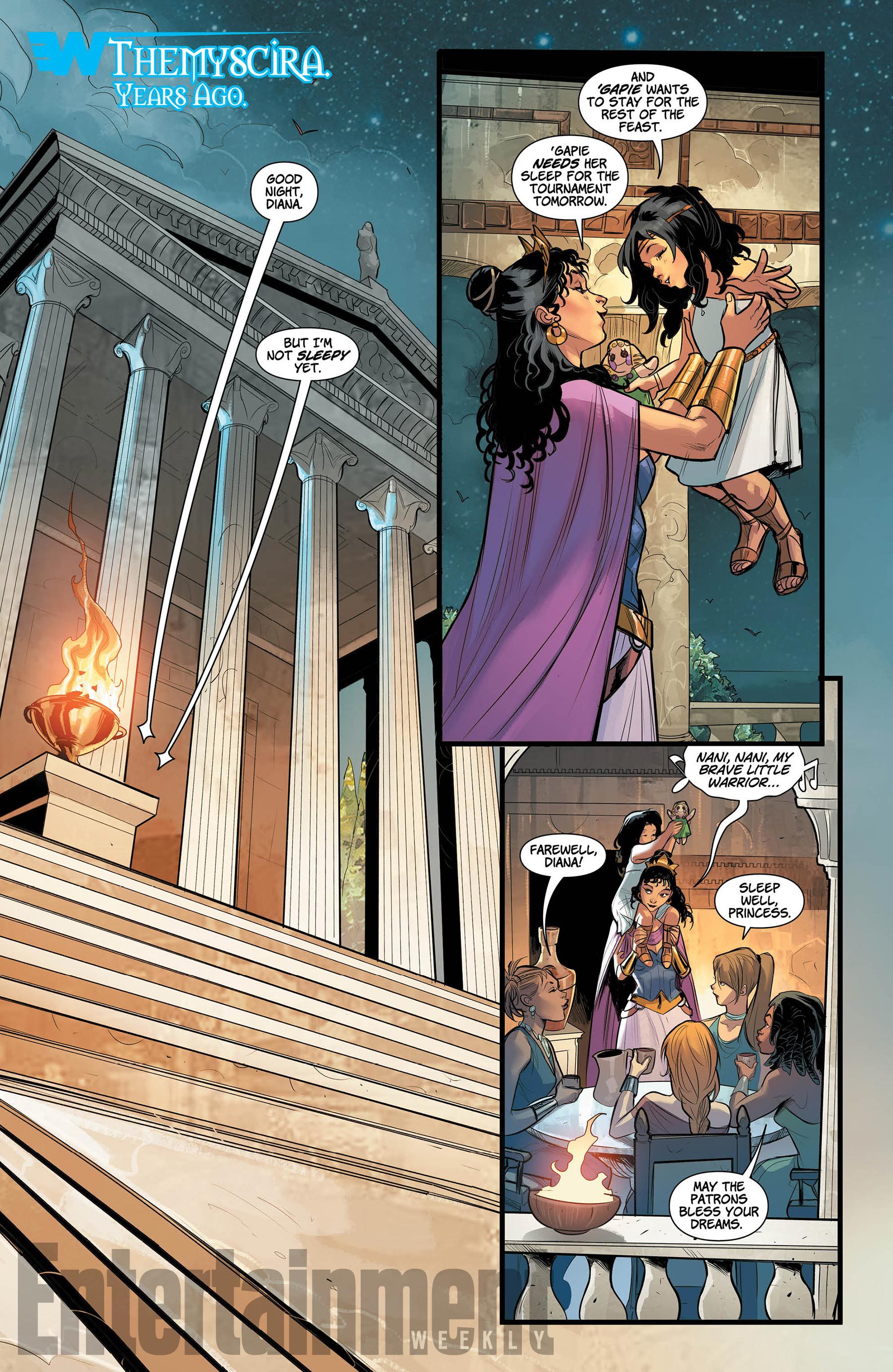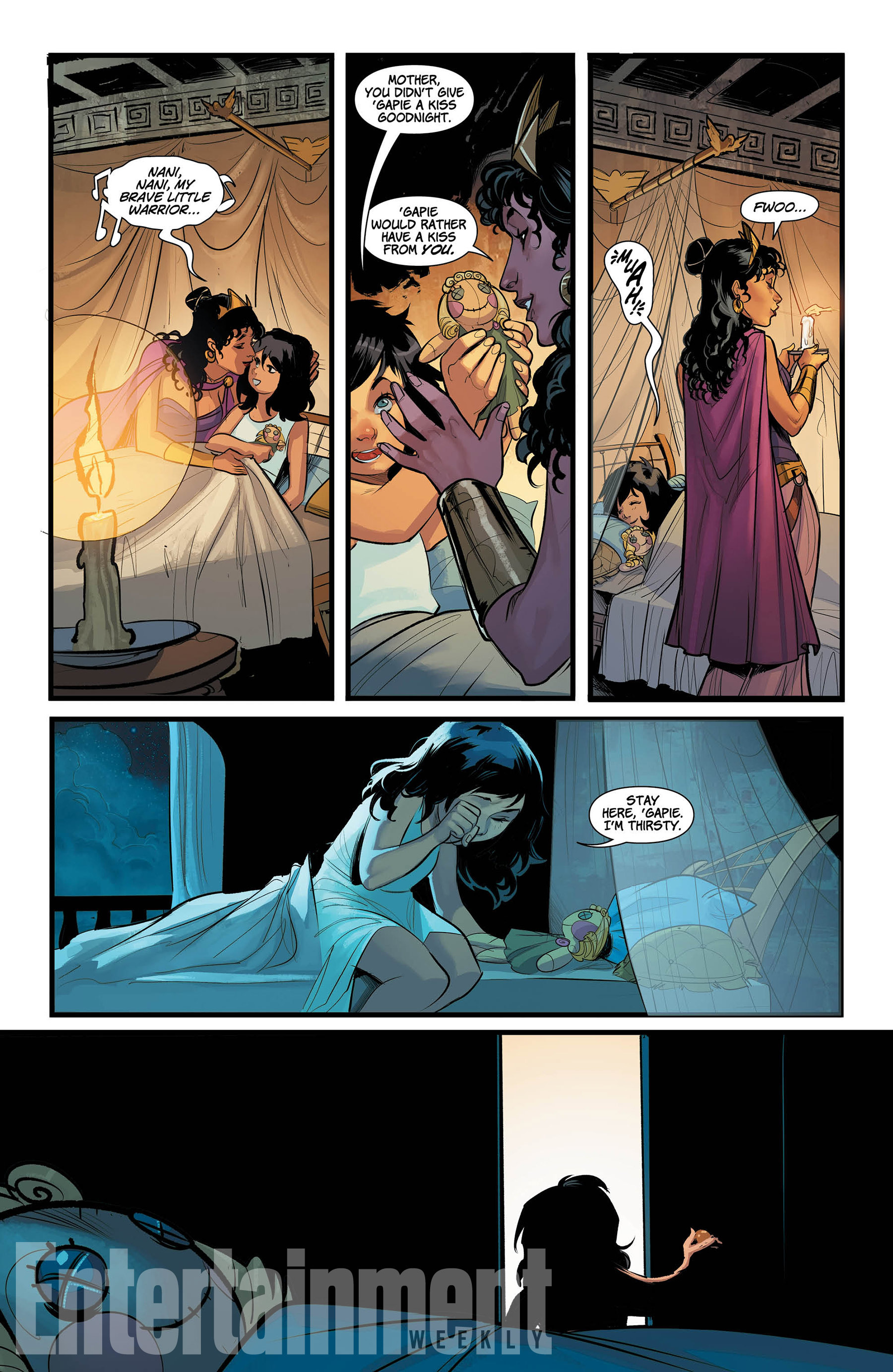A female creative team is something of a rarity for Wonder Woman comics. The character was originally created by William Moulton Marston, and many of her most famous storylines were penned by male authors like Greg Rucka and George Perez. At the same time, director Patty Jenkins and star Gal Gadot just proved with their blockbuster Wonder Woman film that female creators can take the character to new heights.
EW recently caught up with one half of the new creative team for Wonder Woman, Shea Fontana (who is teaming up with Mirka Andolfo for a six-issue run starting with Wonder Woman #26) to preview her new Wonder Woman run and discuss what the character means at this cultural moment — especially when she’s written by women.
ENTERTAINMENT WEEKLY: You’ve been writing Wonder Woman in the DC Super Hero Girls comic. What will be similar or different about your interpretation of her here?
SHEA FONTANA: She’s a pretty different character in DC Super Hero Girls to where we are with Wonder Woman now, but at her DNA level she’s the same character. She’s certainly more mature in this arc, but I think the things that make her Wonder Woman – her sincerity, her search for peace and justice, her desire to know the truth, those things all really remain the same. She’s certainly at a different point in her life in this arc. She’s seen a lot of things, and she’s trying to hang on to those values that are so important to her when she has seen so much war and devastation in the world. I always find it interesting to make the Lasso of Truth her tool of choice because truth is what allows us to be compassionate for people and allow us to connect with people.
EW: Speaking of war, this issue has several scenes of Diana at a UN refugee camp or interacting with military officials. Her role as an ambassador for peace sets her apart from other superheroes like Batman, who think of themselves as explicitly waging a war. How will you be playing with that here?
SF: In this issue, we take her from this place where she’s been in a lot of battles, she’s basically been fighting nonstop since where she left off in Rucka’s run, and now she is a warrior that fights for peace. But how do you deal with that, and what does that mean when it feels like the battle never ends, even when she comes home? She’s back in the U.S. in the issue, and she’s kind of trying to have a break and act like a normal person and have this time to herself, but she doesn’t really know how to do that. Like anyone returning from war and battle really has to struggle. She’s comfortable on the battlefield, she’s comfortable in war, she knows what her place is there, but when she comes home it’s confusing.
It’s about Wonder Woman finding that even when she’s out of the war zone, there’s all these battles being waged around her. She’s figuring out how to do that, and really at the heart of this arc is the relationship between her and Etta Candy. Here we have two really strong women who put themselves into danger on a daily basis but would also take a bullet for each other. How do you play with that dynamic when they’re both such strong forceful personalities?
EW: Etta Candy was a foundational part of Wonder Woman’s mythos at the start, then she went away for a few decades, and now she is back, though in different forms – here she’s a military intelligence officer, in the film she’s a WWI-era secretary, and originally she’s a college girl. What is the constant about Etta across these different versions, and what does she add to Wonder Woman?
SF: I think what I like about Etta is what a good friend she is. She gives a nice counterpoint to Wonder Woman, she’s the worldly one who knows what’s going on and can help her through these adventures. There was a scene in Rucka’s Year One story where she gives Wonder Woman her first margarita. I thought that was so funny and a perfect moment to show how this relationship works. I love how these two women play off each other. There’s no competition, no gossipy jealousy. It’s just this pure friendship that they have.
EW: You’re working with artist Mirka Andolfo for this story. How do you guys work together and what does she add to your interpretation of Wonder Woman?
SF: Mirka Andolfo has been a really cool artist to work with. She adds a wonderful femininity to Wonder Woman. Sometimes you see her and the interpretation can be very masculine in the art, but Mirka does a great job of balancing, showing that she is a warrior who’s tough and strong but she’s a woman too. Mirka is also great at capturing action and building suspense, as she does in this issue. She’s done a fantastic job. We do write full scripts, so she’s doing a full script, and then we go back and forth as the art comes in and make tweaks. She absolutely has any leeway to make changes because she’s an incredible artist and I completely trust her.
EW: The Wonder Woman movie was highly acclaimed, and one thing it seemed to get credit for was having a female director, Patty Jenkins. You guys are both women working on this comic. What does it mean to have women creators writing Wonder Woman?
SF: There’s definitely a subtext and subtlety that we bring it. As women, we understand a little bit about what it was to be Wonder Woman. It’s not something that’s been impossible for male writers, I think a lot of male writers and artists have done an incredible job with her. But I think you’ll get a little extra dose of Wonder Woman’s feminine side and how she balances that. Especially in the first couple issues, we see her struggling with ‘you can’t be a woman and a warrior at the same time,’ and how she marries those sides.
EW: This arc seems to be partially about Wonder Woman trying to achieve a work-life balance, and that struggle can be harder for women, who are often torn between giving themselves up to others and taking time for themselves, right?
SF: That’s absolutely a theme of this arc: How much of Wonder Woman’s self should she sacrifice? I think of it as a metaphor – you can give one kidney and save one person’s life, or you can give two kidneys and save two lives, but that would be crazy. We have this expectation of superheroes to give and give and give, but how do you preserve yourself when you’re in this position where you know you can give and give and help people, but at what cost?
EW: We get a flashback to Diana’s childhood on Themyscira in this issue, showing her pressured to give up a beloved doll. What do you like about flashbacks like that? Will they continue throughout your run?
SF: Those will continue throughout the arc. That moment was actually slightly personal for me. It’s a lot like something that happened to me when I was a kid. I had this ratty doll and I loved it so much, but my mom said it was gross and I should throw it away. I was trying so hard to be tough for my mom that I was like “okay, I’ll throw away my doll.” It was such a hard thing for me to deal with. Later when I was an adult I told my mom about it and she was like, I had no idea. She actually found one of those dolls on eBay and replaced it because she felt so bad. It’s one of those things where kids, and I see this in the work I do writing for kids, are so desperate to please their parents and show they’re a big girl that sometimes they do things that are very hard, but you don’t even know what the challenge is for them because they’re pretty good at covering up. That’s just one thing I wanted to bring to Wonder Woman, how the expectations for her, being the only girl on Themyscira, were very high. How can she just be a kid when she’s among these Amazons?
EW: Between the 75th anniversary last year and Rucka’s much-celebrated Rebirth run and now the movie, it feels like Wonder Woman is more resonant in the zeitgeist than ever. How does she speak to our current moment?
SF: I think her moment is long past due, and I’m glad she’s finally getting it. It was so cool to be writing the Wonder Woman comic as the movie was coming out and seeing my entire Twitter feed of just people loving it. It also makes a high bar for me, but it was just amazing to see people connecting with this character. It’s not that she wasn’t connecting before, it’s just happening now in a bigger public way. So we have all these lifelong fans who are finally able to see what they dreamt of seeing on the screen for 40 years, and then we have all these new people who are just superhero fans or film fans who now find Wonder Woman and get to love it too. Women’s rights are always moving forward. We had a big year with the Women’s March and seeing how people are really in tune to the struggle for equal rights and equal pay and all those things, that it’s just becoming more public and part of the zeitgeist. Of course, this is how it should be.








